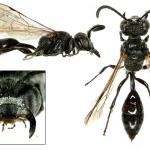Mimesa belgica BONDROIT 1932; Mimesa carbonaria TOURNIER 1899; Mimesa longula GUSSAKOVSKIJ 1932; Psen sameshimai YASUMATSU 1937
The first British specimen of this wasp was collected in 1950, although it was not correctly determined as such until 1975. The females comprise the largest specimens of this genus in Britain.
In Britain, this wasp has only been recorded along the south coast of the Isle of Wight.
Common in central and southern Europe. It has also been recorded from Japan (Lomholdt, 1984).
In Britain it appears to be restricted to several of the Isle of Wight chines, especially around stands of reed (Phragmites australis) around wet flushes, such as are found on landslips or at the bases of clay cliffs (Shirt, 1987). Falk (1991) indicates that abroad it is more normally associated with non-coastal areas where dead wood is a prominent feature. This may possibly result in previously held beliefs about nesting biology (in Richards; see below). Warm, sunny locations appear to be essential.
Falk gives June to August, although the currently limited data set gathered here favours June and July (probably as a result of limited recording).
Richards (1980) gives nymphs of Jassidae, whilst Lomholdt (1984) states "small cicadas". Tsuneki (1959) records certain species of cicadas from the families Cicadellidae and Delphacidae from nests in Japan.
Opinions on nesting behaviour have varied widely. Richards (1980) states that the species nests in decayed wood, but Lomholdt (1984) says sandy or clayey banks. Falk (1991) speculates that in Britain it probably nests in dead reed stems. Else and Felton (1994) cite work by Tsuneki (1959) in Japan, where the species was burrowing in a clay cliff with a nest structure of lateral branches arising from a central burrow. They also record observations from the Isle of Wight of females having mud on their bodies, suggesting they had recently emerged from the ground. Further research on this topic is needed.
No information available.
No cleptoparasites have been observed for this species.
2005


